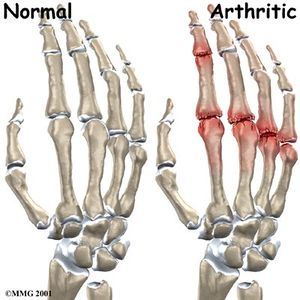Arthritis Hand Function Test (AHFT): Difference between revisions
Rucha Gadgil (talk | contribs) No edit summary |
Rucha Gadgil (talk | contribs) No edit summary |
||
| Line 14: | Line 14: | ||
# Applied Dexterity | # Applied Dexterity | ||
It was developed by Catherine Backman and Hazel Mackie in 1997 and requires purchasing the scoring forms from University of British Columbia, Canada. | It was developed by Catherine Backman and Hazel Mackie in 1997 and requires purchasing the scoring forms from University of British Columbia, Canada. | ||
[[File:Finger arthritis.jpg|thumb]] | |||
== Intended Population == | == Intended Population == | ||
| Line 69: | Line 71: | ||
# Individual lifts one liter of water. Water is added or subtracted depending on the patients’ lifting ability. Scored on the total amount of water obtained. | # Individual lifts one liter of water. Water is added or subtracted depending on the patients’ lifting ability. Scored on the total amount of water obtained. | ||
'''''Scoring''''' | '''''Scoring''''' | ||
Scoring is according to the manual provided. the acquired scores are compared to established normative values. | Scoring is according to the manual provided. the acquired scores are compared to established normative values. | ||
Revision as of 15:06, 24 October 2020
Original Editor - Rucha Gadgil
Top Contributors - Rucha Gadgil and Shaimaa Eldib
Introduction[edit | edit source]
The Arthritis Hand Function Test (AHFT) is an 11-item performance based test designed to measure hand strength and dexterity in persons with arthritis and rhematoid arthritis. It deals with the areas of self-care, work and leisure in such patients.
This test is divided into 4 subscales and tests are performed bilaterally:
- Strength,
- Applied Strength,
- Dexterity, and
- Applied Dexterity
It was developed by Catherine Backman and Hazel Mackie in 1997 and requires purchasing the scoring forms from University of British Columbia, Canada.
Intended Population[edit | edit source]
Useful in both research and clinical applications, the AHFT can be used for pre- and post-operative evaluations, and to measure treatment outcomes pertaining to hand function. It is particularly targeted towards:
- Osteo-arthritis
- Rheumatoid arthritis
- Systemic Sclerosis
Procedure[edit | edit source]
Equipment Required
The equipment required is:
- Sphygmomanometer,
- pinch meter,
- 9-hole pegboard,
- shoe,
- button board,
- 2 safety pins,
- theraplast,
- plate,
- knife and fork,
- coins and a box,
- wooden tray,
- 12 cans of soup,
- pitcher and a glass,
- 1 litre container,
- measuring cup,
- stopwatch.
Training Required
AFHT comes with a scoring and instruction Manual that describes the purpose of the test, the procedure for each item, and instructions for assembly of the test kit. It is not difficult to administer and does not require additional training.
Time Required
The test can be administered in approx. 20 minutes.
Method
The 4 sub-scales are to be administered bilaterally and the scoring noted down on the manual sheet.
Dexterity: performed one hand at a time, 1 time , 1 item
- 9-hole peg test timed for place and removal in a 9-hole pegboard.
Strength: performed one hand at a time, 3 trials, 3 items
- gross grip strength (mm Hg)
- tip pinch with the thumb and index (kg)
- three-point pinch strength with thumb, index and middle finger (kg)
Applied Dexterity: bilateral actions, 5 items
- Fasten and unfasten 4 buttons
- Lace a shoe and tie a bow;
- Pin and unpin two safety pins in a cloth;
- Pick up and manipulate four coins into a slot;
- Cut a piece of putty with a knife and fork into four pieces.
Applied Strength: bilateral actions, 2 items
- Individual lifts a tray with six filled tin cans, which added or subtracted depending on the patients’ lifting ability. Scored on the no. of cans filled (0-12)
- Individual lifts one liter of water. Water is added or subtracted depending on the patients’ lifting ability. Scored on the total amount of water obtained.
Scoring Scoring is according to the manual provided. the acquired scores are compared to established normative values.







